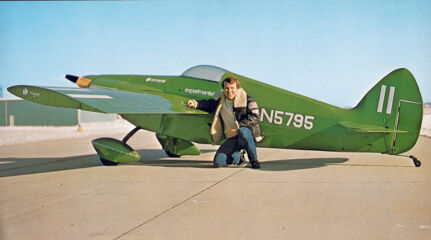-
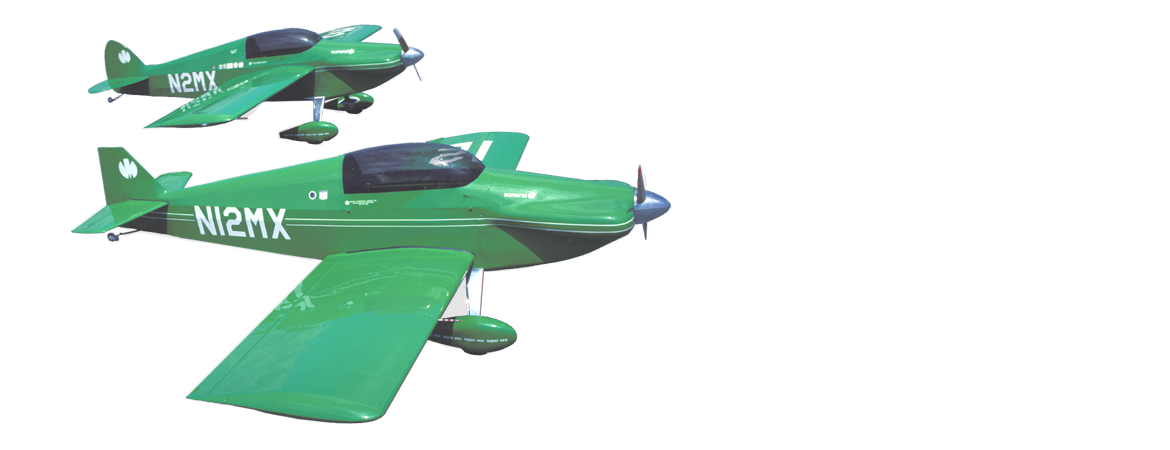
Sonerai Sport Aircraft
Stall Speeds (Vs): 45-50 mph Cruise at Sea Level*: 130-150 mph Cruise at 8,000' (TAS): 140-170 mph G-loads: +6/-6 Range (1): 280-300 miles Gear: Taildragger or Tricycle 1-2 Seats Folding Wings! Plans-Build for:
$21,540


|
Sonerai aircraft models are plans-built aircraft only.
The Bottom Line: What Will My Sonerai Cost? |
The Sonerai family of homebuilt aircraft started it all for Sonex Founder & President and EAA Homebuilt Hall of Fame inductee John Monnett. The Sonerai I was his first design, and was introduced to the world at the 1971 EAA Convention at Oshkosh, WI. It was designed to meet the requirements of the Formula Vee racing rules. The very popular Sonerai II followed in 1973. The low-wing Sonerai IIL followed in 1980, and the Sonerai IILT tricycle geared version in 1983. The Stretched Sonerai IILTS and IILS were introduced in 1984. The Sonerai II in its various versions is among the most popular homebuilt aircraft ever offered, with several thousand built to date. After nearly 50 years, the Sonerai still offers the homebuilder a value that is difficult to match.
| Over the long life of the Sonerai design, thousands of sets of plans have been sold, with several thousand Sonerai’s successfully flown. These serialized plans to build one airplane consist of a Plans Set, Materials List, Detail Components Drawing (all Sonerai II’s), Flight Manual, and a Builder’s Manual with Construction Photos and Wing Construction Manual (Flight Manual, Builder's Manual and Wing Construction Manual authored by long-time Sonerai Newletter Editor Fred Keip). |
| Please Note: The plans set is printed on 11” x 17” paper. They are the original hand drawn plans created in the 1970’s and 1980’s (they are not CAD drawings). All drawing changes are included and noted in the plans. |
There are three separate versions of Sonerai plans available:
|
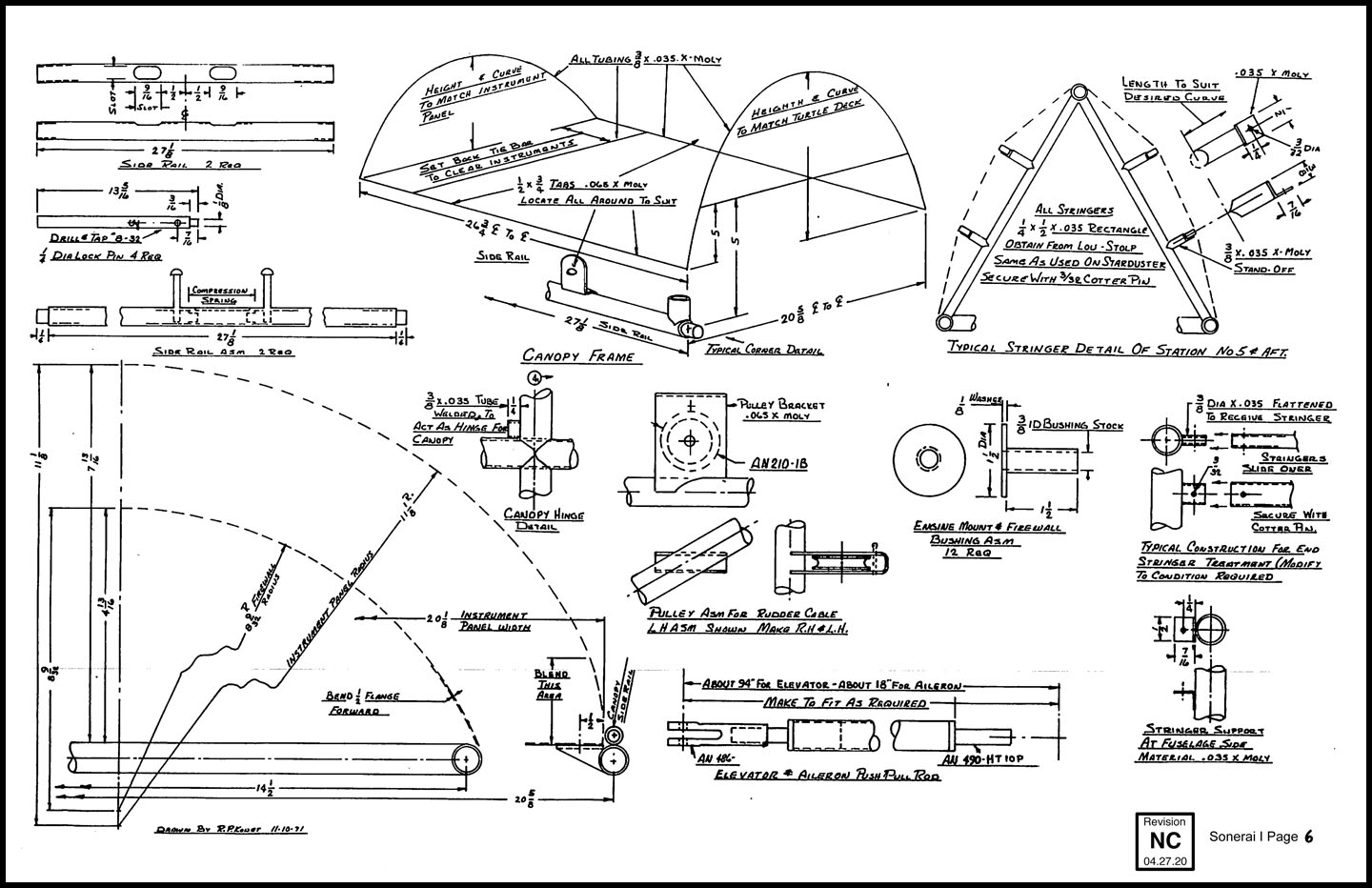 |
| Sample Sonerai Plans Page (click to enlarge) |
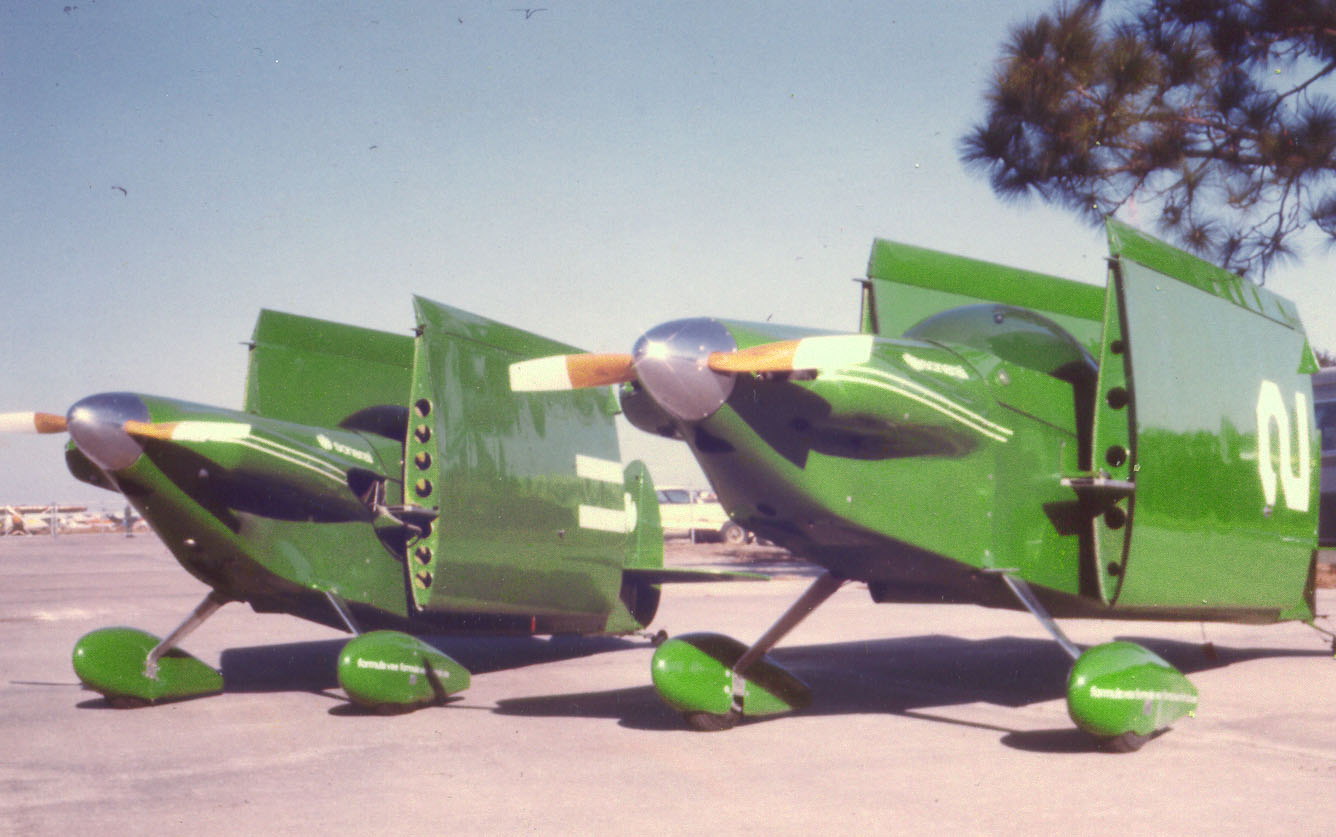 |
| The Sonerai features easily-folding wings for maximum versatility and minimum ownership costs. The wing spars are secured via taper pins in the cockpit, and once removed, the wing is simply folded flat along-side of the fuselage. Built-in provisions secure the folded wing panels to the aft fuselage.
A built-in spar support tube allows the wing fold process to be accomplished by one person. The folding wing design can fit into a garage or share a T-hangar with your flying buddies. It can be towed by the tailwheel on its main gear, or loaded onto a trailer for longer trips. |
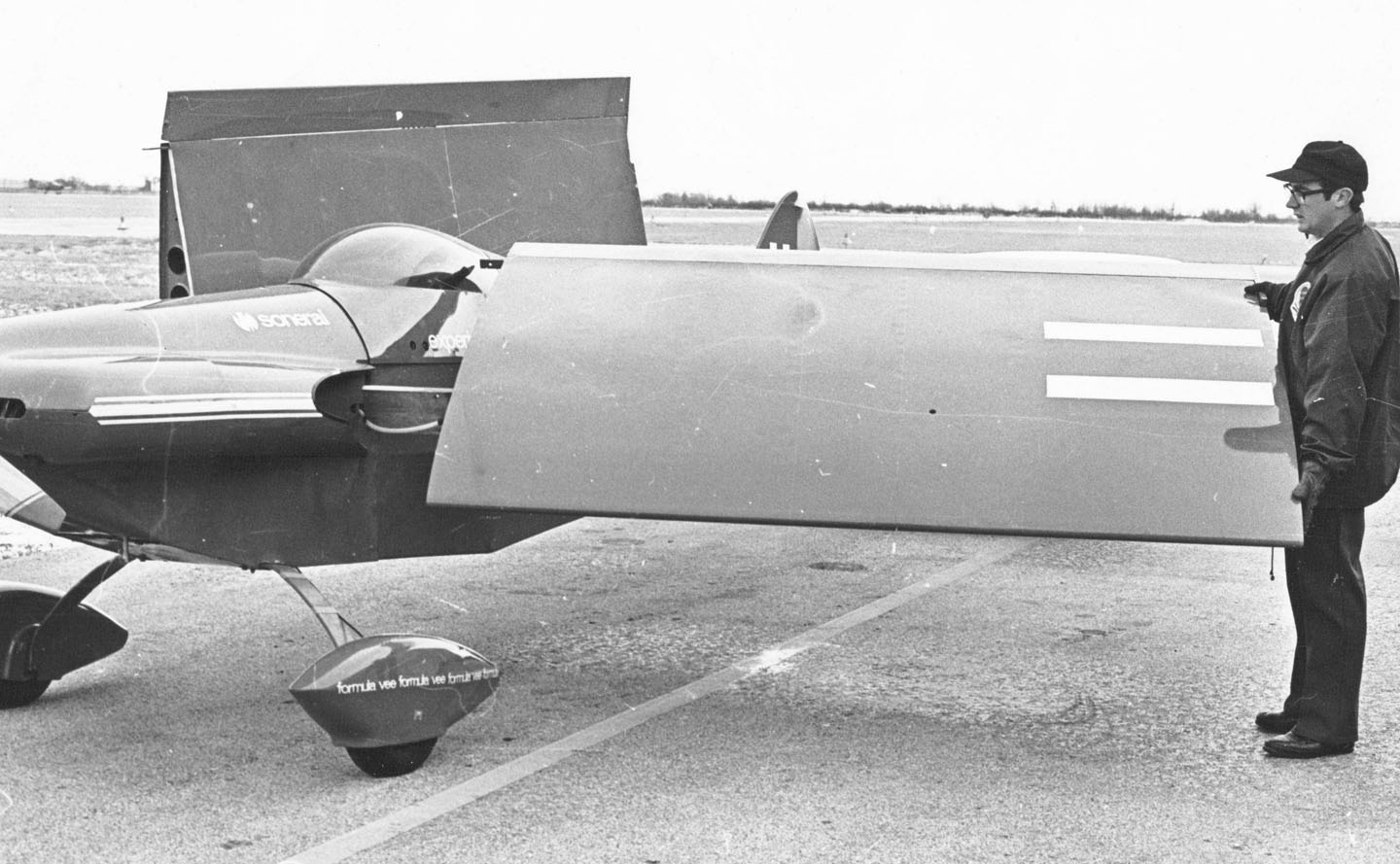 |
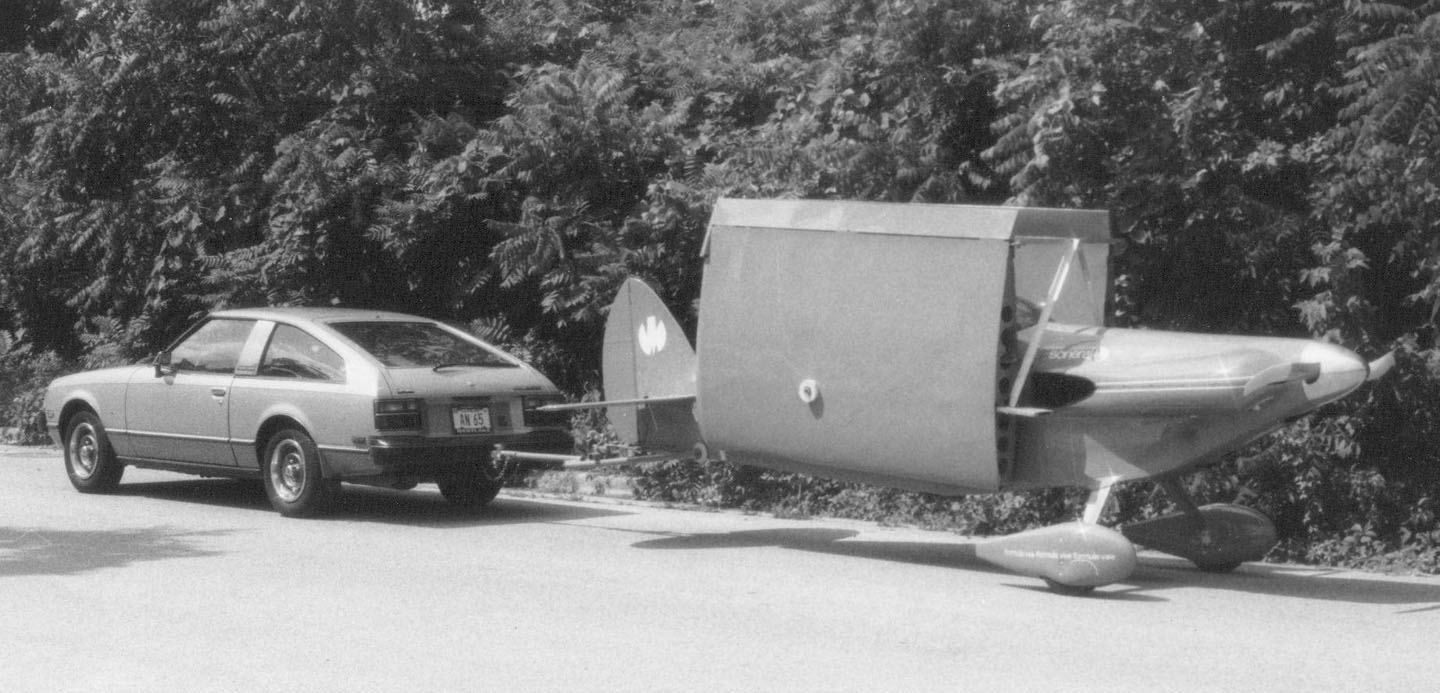 |
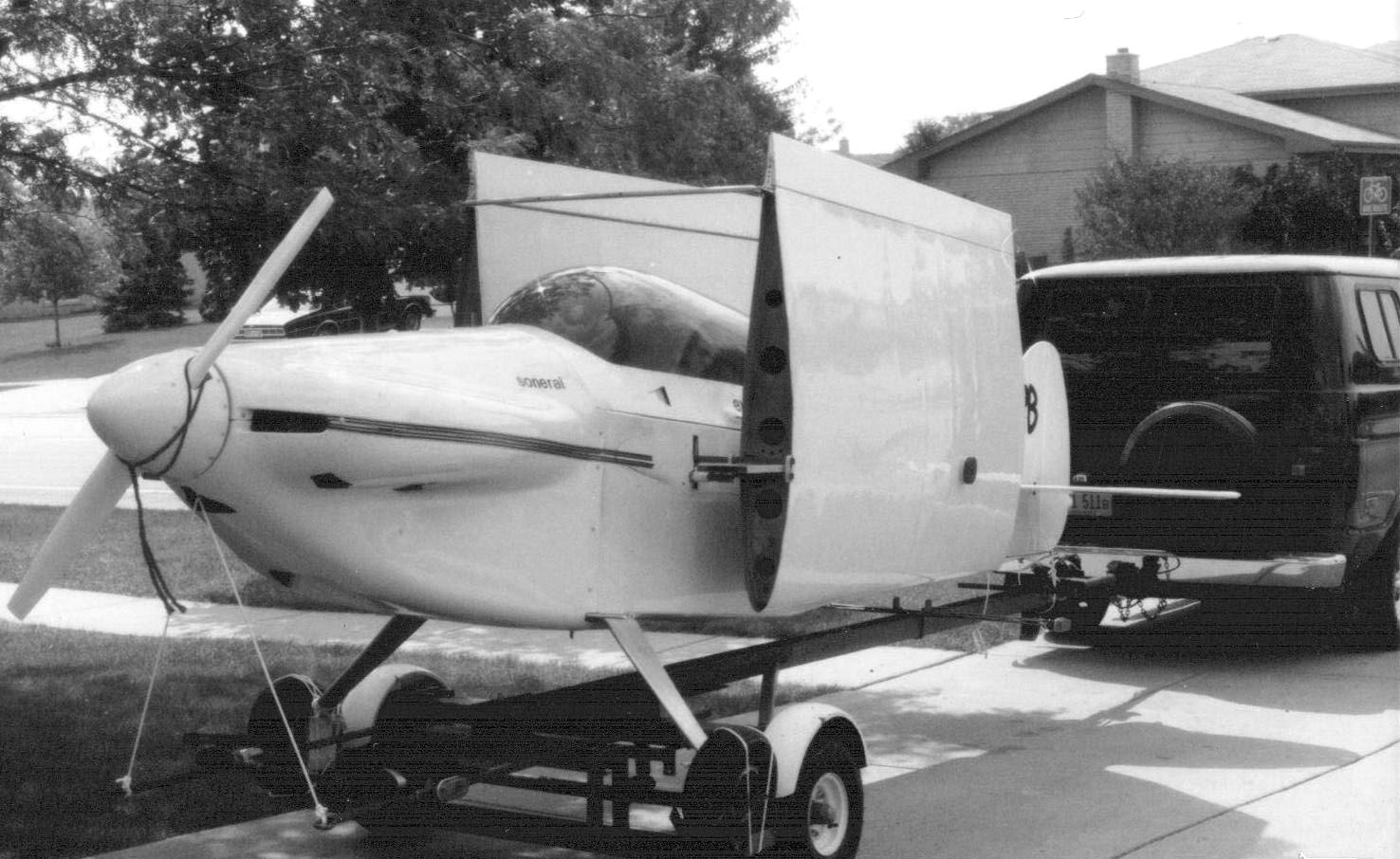 |
|
John Monnett Biography:
|
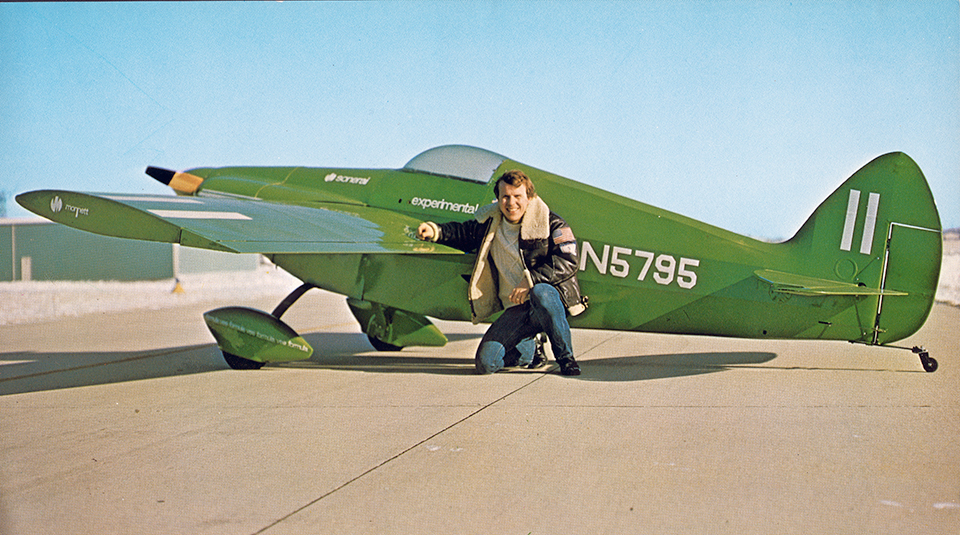 John Monnett and Sonerai I pose for the March 1972 cover of EAA Sport Aviation Magazine.
John Monnett and Sonerai I pose for the March 1972 cover of EAA Sport Aviation Magazine.
The Sonerai I is a mid-wing sport plane racer designed to meet all of the original Professional Race Pilots Association (PRPA) and Formula Vee Racing requirements for 1600cc Volkswagen-powered aircraft. The stock Sonerai I conforms to the SuperVee Air Sports specifications. The Sonerai I will accept engine displacements from 1600cc thru 2180cc. The cockpit is 20” wide.
The wing is composed of two panels that fold alongside the fuselage, enabling the airplane to be towed tail first on its own landing gear. The fuselage and tail surfaces are constructed of standard sizes of 4130 steel tubing, and are fabric covered. The wings are fabricated from aluminum sheet, 0.025” thick for the ribs and skins, and 0.040” thick for the spar channels. Stainless steel flush Cherry N pulled rivets are used for wing skin attachment to simplify assembly. The fiberglass cowling removes easily to allow complete access to the engine, fuel tank, and instruments. The landing gear is a formed aluminum spring manufactured from 5/8” x 5” 2024-T351 bar stock, and uses 5” wheels and ¾” axles. The tailwheel is steerable and the aircraft does not use differential brakes for steering.
| Seats: | 1 |
| Length: | 16' 8" |
| Wing Span: | 16' 8" |
| Wing Area: | 75 sq. ft. |
| Height: | 5' |
| Tail Configuration: | Conventional |
| Primary Structure - Wings: | Aluminum |
| Primary Structure - Fuselage & Tail: | 4130 Steel Tube & Fabric |
| Cockpit Width: | 20 in. |
| Fuel Capacity: | 11 US Gal. |
| Stall Speed: | 40 mph [64.37 km/h] |
| Manuevering Speed (Vne): | 120 mph [193 km/h] |
| Never Exceed Speed (Vne): | 225 mph [362 km/h] |
| Performance | 1600 cc. V.W. | 80 hp 2180 AeroVee |
|---|---|---|
| Empty Weight | 440 lbs. [199.6 kg] | 490 lbs. [222.25 kg] |
| Gross Weight | 700 lbs. [317.5 kg] | 750 lbs. [340.2 kg] |
| Useful Load | 260 lbs [118 kg] | 260 lbs [118 kg] |
| Range | 325 miles | 325 miles |
| Cruise Speed | 150 mph | 170 mph |
| T.O. Distance | 600 ft | 400 ft |
| Landing Distance | 500 ft | 500 ft |
| Rate of Climb | 800 fpm | 1000 fpm |
| Positive Load Factor | +6.0 Gs | +6.0 Gs |
| Negative Load Factor | -6.0 Gs | -3.0 Gs |
|
Specifications subject to change without notice. |
The Sonerai II (original) is one of the most versatile two-place homebuilt airplanes ever conceived, and can be built in several versions. In its original form, the standard Sonerai II is a mid-wing, two-place tandem, tailwheel airplane that is flown from the rear seat solo. The Sonerai IIL is the same airplane but with a low wing. The IIL is especially popular with taller pilots, as the pilot’s legs go over the top of the main spar carry-thru structure, rather than under it. The Sonerai IILT is the same as the IIL except that it is built with a steerable nosewheel (“T” for tricycle). Many builders with limited taildragger experience opt for the tricycle gear. The Sonerai II will accept engine displacements from 1700cc thru 2180cc. The cockpit is 23-1/4” wide.
The wing is composed of two panels that fold alongside the fuselage, enabling the airplane to be towed tail first on its own landing gear. The fuselage and tail surfaces are constructed of standard sizes of 4130 steel tubing, and are fabric covered. The wings are fabricated from 2024-T3 Alclad aluminum sheet, 0.025” thick for the ribs and skins, and 0.040” thick for the spar channels. Stainless steel flush Cherry N pulled rivets are used for wing skin attachment to simplify assembly. The fiberglass cowling removes easily to allow complete access to the engine, fuel tank, and instruments. The landing gear is a formed aluminum spring manufactured from 5/8” x 6” 2024-T351 bar stock, and uses 5” wheels and 3/4” axles. A tapered rod tail spring is used for the tailwheel. All Sonerai II versions feature a 10 gallon main fuel tank with the option for a 6 gallon auxiliary tank.
| Seats: | 2 (tandem) |
| Length: | 18' 10" |
| Wing Span: | 18' 8" |
| Wing Area: | 84 sq. ft. |
| Height: | 5' 6" |
| Tail Configuration: | Conventional |
| Primary Structure - Wings: | Aluminum |
| Primary Structure - Fuselage & Tail: | 4130 Steel Tube & Fabric |
| Cockpit Width: | 23-1/4 in. |
| Fuel Capacity: | 10 US Gal. (+6 Gal. Aux Tank Optional) |
| Stall Speed: | 45 mph [72.42 km/h] |
| Manuevering Speed (Vne): | 115 mph [185 km/h] |
| Never Exceed Speed (Vne): | 200 mph [322 km/h] |
| Performance | 1700 cc. V.W. | 80 hp 2180 AeroVee |
|---|---|---|
| Empty Weight | 506 lbs. [229.5 kg] | 520 lbs. [235.9 kg] |
| Range | 300 miles | 300 miles |
| Cruise Speed | 140 mph | 140 mph |
| T.O. Distance | 800 ft | 600 ft |
| Landing Distance | 500 ft | 500 ft |
| Normal Category | 1700 cc. V.W. | 80 hp 2180 AeroVee |
| Gross Weight | N/A | 1150 lbs. [521.6 kg] |
| Useful Load | N/A | 630 lbs [285.76 kg] |
| Rate of Climb | N/A | 500 fpm |
| Positive Load Factor | N/A | +3.8 Gs |
| Negative Load Factor | N/A | -1.52 Gs |
| Utility Category | 1700 cc. V.W. | 80 hp 2180 AeroVee |
| Gross Weight | 950 lbs. [430.9 kg] | 950 lbs. [430.9 kg] |
| Useful Load | 444 lbs [201.4 kg] | 430 lbs [195 kg] |
| Rate of Climb | 500 fpm | 700 fpm |
| Positive Load Factor | +4.4 Gs | +4.4 Gs |
| Negative Load Factor | -2.2 Gs | -2.2 Gs |
| Aerobatic Category | 1700 cc. V.W. | 80 hp 2180 AeroVee |
| Gross Weight | 750 lbs. [430.9 kg] | 750 lbs. [430.9 kg] |
| Useful Load | 244 lbs [110.7 kg] | 230 lbs [104.3 kg] |
| Rate of Climb | 700 fpm | 900 fpm |
| Positive Load Factor | +6 Gs | +6 Gs |
| Negative Load Factor | -3 Gs | -3 Gs |
|
Specifications subject to change without notice. |
The Sonerai II Stretch is the last of the Sonerai family to be offered. The Stretch airplanes are 18” longer than the Original, with 6” added to the front cockpit to provide more room for the front seat passenger, and 12” added behind the rear seat to provide proper balance. It can be built in one of two versions. The Sonerai IILS is a low-wing, two-place tandem, tailwheel airplane that is flown from the rear seat solo. The Sonerai IILTS is the same airplane but it is built with a steerable nosewheel (“T” for tricycle). Many builders with limited taildragger experience opt for the tricycle gear. The Sonerai II Stretch is designed to use the 2180cc VW engine. The cockpit is 23-1/4” wide.
The wing is composed of two panels that fold alongside the fuselage, enabling the airplane to be towed tail first on its own landing gear. The fuselage and tail surfaces are constructed of standard sizes of 4130 steel tubing, and are fabric covered. The wings are fabricated from 2024-T3 Alclad aluminum sheet, 0.025” thick for the ribs and skins, and 0.040” thick for the spar channels. Stainless steel flush Cherry N pulled rivets are used for wing skin attachment to simplify assembly. The fiberglass cowling removes easily to allow complete access to the engine, fuel tank, and instruments. The landing gear is a formed aluminum spring made from 5/8” x 6” 2024-T351 bar stock, and uses 5” wheels and ¾” axles. A tapered rod tail spring is used for the tailwheel. All Sonerai II versions feature a 10 gallon main fuel tank with the option for a 6 gallon auxiliary tank.
| Seats: | 2 (tandem) |
| Length: | 20' 4" |
| Wing Span: | 18' 8" |
| Wing Area: | 84 sq. ft. |
| Height: | 5' 5" |
| Tail Configuration: | Conventional |
| Primary Structure - Wings: | Aluminum |
| Primary Structure - Fuselage & Tail: | 4130 Steel Tube & Fabric |
| Cockpit Width: | 23-1/4 in. |
| Fuel Capacity: | 10 US Gal. (+6 Gal. Aux Tank Optional) |
| Stall Speed: | 50 mph [80.47 km/h] |
| Manuevering Speed (Vne): | 115 mph [185 km/h] |
| Never Exceed Speed (Vne): | 200 mph [322 km/h] |
| Performance | 80 hp 2180 AeroVee |
|---|---|
| Empty Weight | 540 lbs. [245 kg] |
| Range | 300 miles |
| Cruise Speed | 140 mph |
| T.O. Distance | 600 ft |
| Landing Distance | 500 ft |
| Normal Category | 80 hp 2180 AeroVee |
| Gross Weight | 1150 lbs. [521.6 kg] |
| Useful Load | 610 lbs [276.7 kg] |
| Rate of Climb | 500 fpm |
| Positive Load Factor | +3.8 Gs |
| Negative Load Factor | -1.52 Gs |
| Utility Category | 80 hp 2180 AeroVee |
| Gross Weight | 1010 lbs. [458.13 kg] |
| Useful Load | 470 lbs [213.2 kg] |
| Rate of Climb | 700 fpm |
| Positive Load Factor | +4.4 Gs |
| Negative Load Factor | -2.2 Gs |
| Aerobatic Category | 80 hp 2180 AeroVee |
| Gross Weight | 750 lbs. [430.9 kg] |
| Useful Load | 210 lbs [95.25 kg] |
| Rate of Climb | 900 fpm |
| Positive Load Factor | +6 Gs |
| Negative Load Factor | -3 Gs |
|
Specifications subject to change without notice. |
Sonerai’s are "Plans-Built" aircraft, therefore build costs are widely variable and you can build one over-time as you can afford it.
| Sonerai / 1600-1700cc VW | Sonerai / AeroVee 80hp | |
|---|---|---|
| Sonerai Plans | $145 | $145 |
| Airframe Materials (1) | $10,000 | $10,000 |
| Fabric Covering Materials & Paint (2) | $1,600 | $1,600 |
| Engine (3) | $6,000 | $11,300 |
| FWF/Misc. (4) | $600 | $600 |
| Instruments (4) | $2,200 | $2,200 |
| Propeller (5) | $1,528 | $1,528 |
| Total: | $21,540 | $25,592 |
*This chart / worksheet is provided to help you calculate an estimated finished cost of your airplane. While these finished costs are accurate as of the date of publication, they are not guaranteed. Some of the items needed to finish your aircraft are not provided by Sonex.
All Prices Subject to Change without notice.
| ||
| Seats: |
|
| Landing Gear: |
|
| Controls: |
|
| Engines: |
|
| Wing Configuration: |
|
As a scratch-build project, you will be fabricating most of the parts yourself from raw materials using the information shown in the plans. Some components you will need are manufactured and sold by Sonex and other suppliers, as follows:
Langaire Aircraft Parts LLC
Phone: 503-397-1478
www.langaire.com
Airplane Plastics
Phone: 937-669-2677
airplaneplastics.com
Sheer Technologies
Greg Klemp
Phone: 920-229-2041
|
Flight Data & Engine Monitoring Instrument Packages Available starting at: $1,363.50. Read More about Sonex Instrument Options |
Like all other Sonex Aircraft, the Sonerai is a perfect fit for the AeroConversions AeroVee Engine. Our simple, low cost, and technically advanced 2180cc 80hp AeroVee Engine Kit is offers the best possible performance for your Sonerai, along with outstanding economy.
Customers may optionally install smaller VW-based engines 1600cc or larger in the Sonerai I, and 1700cc or larger in the Sonerai II.
All Sonerai’s are PLANS-BUILT homebuilt experimental amateur-built airplanes. They are NOT available in kit form. For the budget-conscious builder, this means that there is no need to spend a large sum of money to get started on your project. You can spend the money as it becomes available. It also means that you are going to exchange a lot of sweat equity for that large sum of money by scratch-building most of the components that make up the airframe. Many of the hard-to-make components, though, are available from Sonex Aircraft and other suppliers.
The Sonerai consists of a welded 4130 steel tube space-frame fuselage with welded tail surfaces, that are covered with Dacron fabric. The wings are all aluminum, and are attached to the fuselage with three pins for each of the two wing panels. The main landing gear is a formed aluminum spring that is bolted directly to the fuselage structure, and the tailwheel spring is a machined and heat treated tapered steel rod with a cast aluminum swivel caster and ball bearing equipped rubber wheel. (For nose wheel equipped airplanes, the nose wheel strut is fabricated from 4130 steel.) The entire front of the airplane, from the spinner to the instrument panel is covered by a two-piece fiberglass cowling. The canopy is a blown acrylic plastic bubble. And the controls are standard 3-axis, with a control stick and rudder pedals.

The Sonerai fuselage is a welded space frame constructed entirely of AISI 4130 normalized steel tubing and sheet stock. The tubing is cut and fitted together using a wooden jig table. It is built much like an old balsa wood model, where the two sides are tack welded, then set up on edge, and tied together with additional tubes. The welding can be performed using either the oxygen-acetylene process, or the TIG process. Most first-time builders choose the oxy-acetylene process due to the significantly lower cost for the welding equipment. The two processes are easy to learn, requiring only practice to perfect the skills.
The fuselage is designed to provide maximum strength, pilot and passenger comfort, and ease of construction. The seat frames, controls, canopy frame, roll over structure, engine attach points, and main spar carry-thru structure are all made from 4130 steel.
The Sonerai I has an inside cockpit width of 20”. The Sonerai II (both Original and Stretch) has an inside cockpit width of 22-1/2”. The pilot cabin for all Sonerai’s is 27-5/8” long excluding leg room. The passenger (front) compartment on the Sonerai II Original is 19” long, while on the Sonerai II Stretch is is 25” long, again excluding leg room. The fuselage represents 40% to 50% of the total construction time.
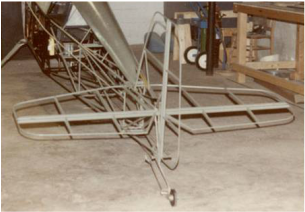
The vertical and horizontal stabilizer, rudder, and elevator on the Sonerai are fabricated from AISI 4130 normalized tubing and sheet stock. The rudder is sufficient to provide excellent control response during crosswind landings. The horizontal stabilizer can be ground adjusted to remove excessive stick forces. Neither the rudder or elevator have external trim tabs (although information for elevator trim systems is available). The entire empennage is fabric covered.
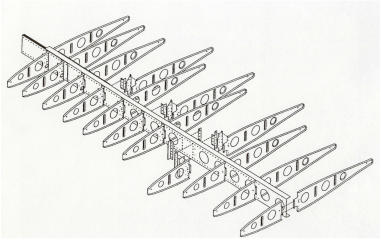
The Sonerai wings use a modified NACA 64A212 laminar flow airfoil with a 54” chord length. They are fabricated entirely of aircraft-grade aluminum. The spars are made up of 0.040” thick 2024-T3 Alclad bent c-channels that are reinforced with 1/8” x 1-1/4” 2024-T3 cap strips and 1/8” x 1-1/4” x 1-1/4” 6061-T6 angles. The wing ribs are formed from 0.025” thick 2024-T3 Alclad sheet, and the wing skins are 0.025” thick 2024-T3 Alclad sheets that cover the wing from trailing edge to trailing edge. The spars are assembled with AN470-AD-5 and AN426-AD-5 bucked rivets. The skins are secured to the spars and ribs with Cherry N flush stainless pulled rivets. The ailerons are full span with each skin being formed from one piece of 0.020” thick 2024-T3 alclad. The wings have a built-in folding mechanism to allow the wings to fold against the sides of the fuselage for transport or storage.
The Sonerai’s use a conventional 3-axis control system. A center-mounted control stick (removable from the front cockpit of the Sonerai II) controls pitch and roll. Both the ailerons and the elevator are actuated by push-pull tubes. The rudder is controlled by adjustable rudder pedals actuated by 1/8” aircraft cables. The controls of the Sonerai are crisp, and light to the touch. The aileron and rudder controls feature adjustable control horns that can increase or decrease the control surface’s reaction to the pilot’s inputs. The throttle lever(s) is mounted on the left side of the cockpit. The brakes are hand-lever actuated on the Sonerai II’s, and toe-actuated on the Sonerai I.
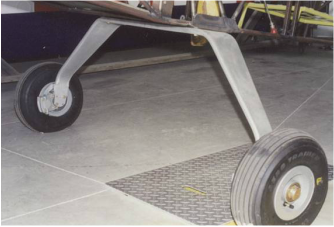
All Sonerai main landing gears are made from aircraft grade 2024-T351 aluminum bar stock. The Sonerai I uses 5/8” x 5” stock, while the Sonerai II’s use 5/8” x 6” stock. The Sonerai II series has a gear stance of approximately 60”. All Sonerai’s use Asuza 5” wheels with ¾” axles, and 5:00x5 tires. Cleveland 5:00x5 wheels and axles are also commonly used. Either mechanical drum brakes, or hydraulic disc brakes can be used. The main landing gear is available from O'Keefe Aero, Ltd.
The tailwheel is mounted on an AISI 5150 machined, heat treated, and tapered tail spring. An aluminum swivel with a 4” tail wheel is mounted on the spring. It is directly connected to the rudder for positive steering control on the ground. The nosewheel is mounted in a fully-steerable strut and fork made from AISI 4130 steel. The strut is mounted with a spring for shock absorption.
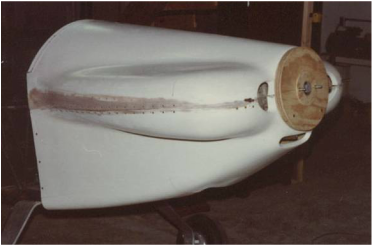
The two-piece cowling, as used on all Sonerai models, is made of fiberglass. It is rigid and light weight. The cowling on the Sonerai is unique among most homebuilts because it extends from the spinner to the instrument panel. When it is removed, you have access to the entire forward portion of the airplane, allowing maintenance and inspection of the instrument panel, fuel system, forward controls, and the entire engine compartment. Removal is simple. There are several fasteners that attach the cowling to the fuselage, and two piano hinges that hold the two cowling halves together. The cowlings are available from Sonex Aircraft.
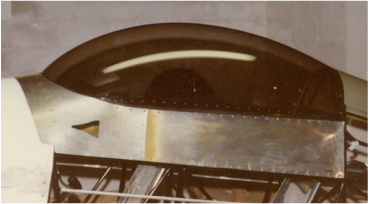
The canopy for the Sonerai I and Sonerai II is made from 1/8” acrylic (Plexiglass), precision molded, with excellent optics. It is mounted to a 4130 steel frame with an aluminum skirt, is hinged on the right side of the cockpit, and latched on the left side.
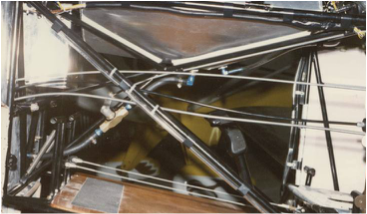
The fuel system on all of the Sonerai’s is a simple and reliable gravity-feed system. The main fuel tank is mounted in the forward fuselage between the firewall and the instrument panel. The tanks are fabricated from aluminum and are constructed so that all of the fuel is useable. The Sonerai I tank has a capacity of 11 gallons, while the Sonerai II tank holds 10 gallons. The Sonerai II Stretch plans also show the option of an additional 6 gallon auxiliary fuel tank permanently mounted in the turtledeck aft of the pilot’s seat. The main fuel tank uses a simple and reliable sight gauge to monitor fuel level.
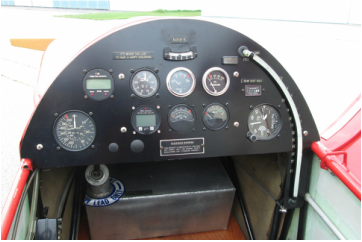
The Sonerai is designed to be a BASIC VFR AIRPLANE. The instrument panel is not large, so there is room for only basic VFR instrumentation (airspeed indicator, altimeter, compass, tachometer, oil pressure, oil temperature, EGT/CHT, and voltmeter). Installing an electronic EFIS panel will, of course, increase capabilities. Also, because of the small size of the cockpit, minimal avionics are suggested, like a handheld comm radio, and GPS. A transponder and encoder will be required if you must fly in airspace requiring them. Learn more about economical and light-weight instrument options available from Sonex Aircraft!
A newsletter for Sonerai builders was published between 1973 and 2010 by various editors. Archives of these popular newsletters are now available for Free Download below!
